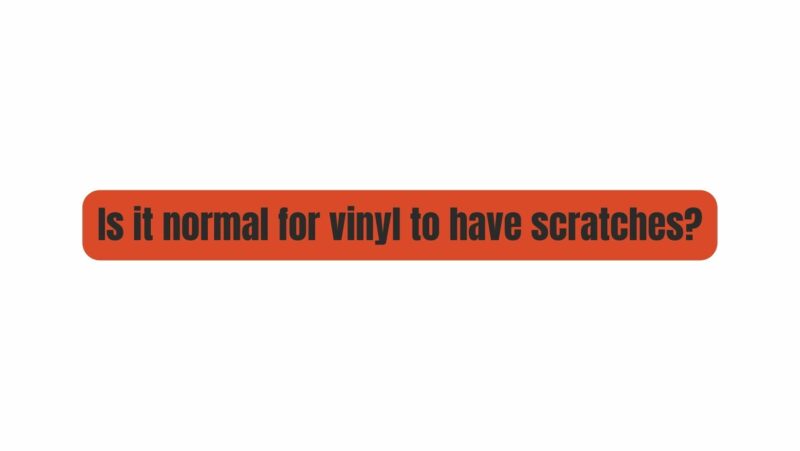Vinyl records, cherished for their warm analog sound and tactile appeal, have experienced a remarkable resurgence in recent years. Yet, whether you’re a seasoned vinyl collector or a newcomer to the world of vinyl, you’ve likely encountered scratches on records. This raises a fundamental question: Is it normal for vinyl to have scratches? In this article, we will explore the inherent imperfections of vinyl records, how scratches occur, their impact on sound quality, and practical tips for handling and caring for your vinyl collection.
The Nature of Vinyl Records
Before we delve into the matter of scratches on vinyl records, it’s important to understand the fundamental nature of vinyl as a medium for storing music:
- Physical Grooves: Unlike digital formats, vinyl records store audio as physical grooves. When a stylus or needle travels along these grooves, it reproduces the sound by interpreting the variations in the groove’s depth and direction.
- Delicate Surface: Vinyl records have a relatively delicate playing surface. Even minor imperfections or dust particles can affect playback.
- Tactile Experience: Vinyl records offer a tactile and immersive listening experience that connects the listener directly to the music and the analog playback process.
The Occurrence of Scratches
Vinyl records can acquire scratches due to various reasons:
- Handling: Mishandling records, such as dropping them, careless storage, or improperly placing the stylus on the grooves, can result in surface scratches.
- Dust and Debris: Dust and debris on the record’s surface can act as abrasives, causing scratches when the stylus travels across them during playback.
- Worn Stylus: A worn or damaged stylus can dig into the grooves and create deep scratches over time.
- Cleaning Practices: Cleaning records with abrasive materials or using excessive force can introduce scratches.
Are Scratches Normal?
In the context of vinyl records, scratches are not uncommon and can be considered a normal part of the medium’s lifespan. Over time, especially with frequent use, it’s typical for records to accumulate surface scratches. These minor imperfections often result from normal wear and tear and should not be a cause for undue concern.
Surface scratches on vinyl records are usually shallow and do not necessarily affect the overall sound quality or listening experience. They may manifest as minor pops or clicks during playback, which many vinyl enthusiasts accept as part of the analog charm. In fact, some collectors appreciate the character that these imperfections lend to their records.
Deep Scratches and Their Impact
While surface scratches may be considered normal and tolerable, deep scratches can have a more significant impact on sound quality:
- Pops and Clicks: Deep scratches can lead to audible pops and clicks that interrupt the music, affecting the overall listening experience.
- Distortion: Depending on their severity and location, deep scratches can cause distortion in the audio, altering the original recording and potentially making it less enjoyable.
- Tracking Issues: In severe cases, deep scratches can disrupt the tracking of the stylus, causing it to skip ahead or even jump out of the groove.
Preventing and Managing Scratches
While scratches are a normal part of vinyl’s life cycle, you can take proactive steps to prevent and manage them:
- Proper Handling: Always handle records with clean hands and grasp them by their edges to avoid touching the playing surface.
- Storage: Store records upright in protective sleeves and keep them away from direct sunlight and extreme temperatures.
- Cleaning: Regularly clean your records using an anti-static brush or a record cleaning machine to remove dust and debris.
- Stylus Maintenance: Ensure your turntable’s stylus is clean and in good condition to minimize the risk of damaging your records.
When to Be Cautious
While minor surface scratches are generally considered normal and can be tolerated, there are instances when caution is warranted:
- Deep Scratches: If a record has deep scratches that significantly impact sound quality or tracking, it may be worth considering professional restoration or retiring the record from regular use.
- Valuable Records: For valuable or rare records, take extra precautions to minimize wear and consider professional restoration when necessary.
Conclusion
In the world of vinyl records, scratches are an inherent part of the medium’s character. While minor surface scratches are normal and should not deter you from enjoying your vinyl collection, deep scratches can impact sound quality and may require attention.
Ultimately, the appreciation of vinyl records extends beyond their imperfections. The tactile experience, the nostalgia, and the analog warmth they offer continue to captivate audiophiles and collectors worldwide. By understanding the nature of scratches and taking proactive steps to care for your vinyl records, you can ensure that your cherished collection provides countless hours of musical enjoyment for years to come, scratches and all.


